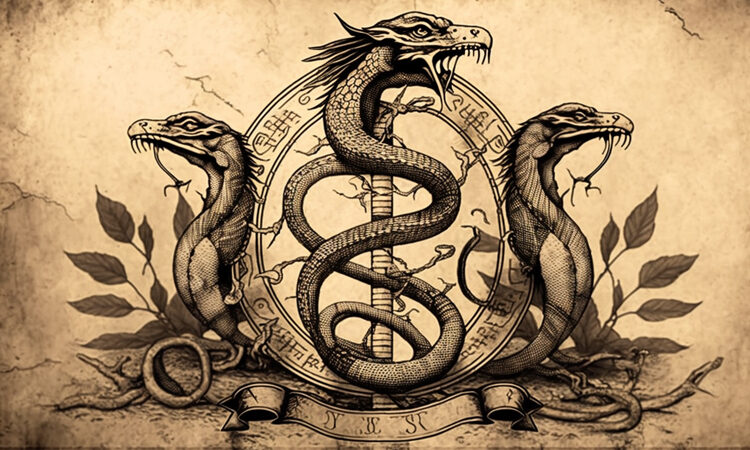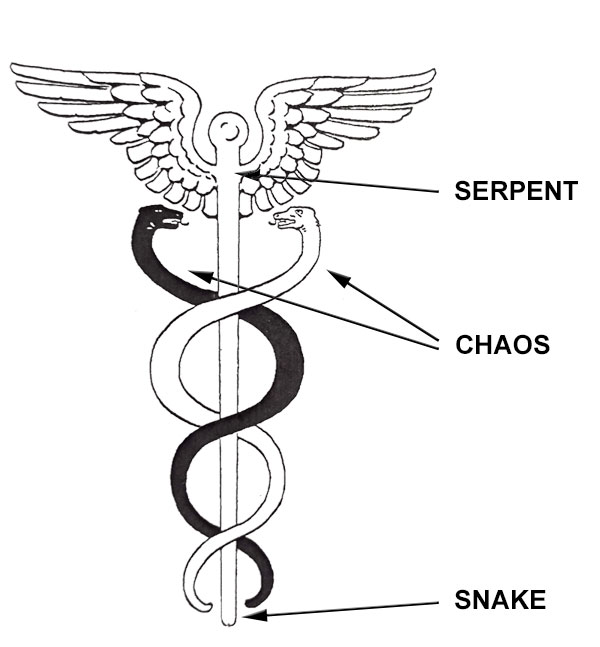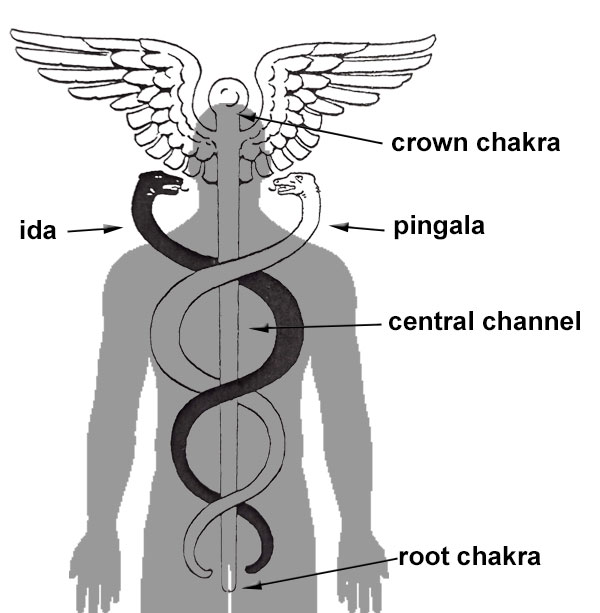Introduction
One of the most prominent symbols in ancient religions and mythologies is that of the serpent (and its variants). In Christian theology, the serpent represents Satan and is evil. The Bible also mentions variations of the serpent symbol: a dragon (in Revelation) and leviathan (in the Old Testament). In Jewish mysticism, the devil is named Samuel and is characterized as a flying serpent. In Sumerian mythology, the god Marduk battles the dragon before the creation of the world.
Many cultures and traditions did not perceive the serpent as evil, however. The ancient Mayans worshiped their feathered serpent as a god, while the Aboriginals of Australia revere a rainbow serpent. In Greek mythology, the healing god Asclepius had a serpent wrapped around his staff, while the staff of the messenger god Hermes had two serpents. The Biblical “messenger of God” Moses also had a staff with a bronze serpent, and this staff was specifically designed to treat “snake bites.” In Ancient Egypt, certain gods were depicted with cobras on their foreheads to indicate that they were enlightened beings. Yet the serpent was also responsible for biting (and thus poisoning) Ra, who was important Egyptian god.
When Jesus asked his followers to be “as wise as serpents,” he was obviously equating the serpent with wisdom. Yet it is the snake who tempted Eve in the garden to disobey God. To make any sense out of the symbolism, we must theorize that the serpent can be a symbol for both good and evil. But how exactly is this possible? The answer lies in the complex nature of the serpent symbol.
Yahweh and the Snake: A Closer Look
Roughly 2500 years ago, there was a mystery school in ancient Greece whose name derived from the a mythological figure known as Orpheus. The name Orpheus is derived from a word that means “snake.” In the Orphic tradition, it was believed that the universe was hatched out of an snake’s egg (the Orphic Egg). Hinduism has a similar tradition: the universe was created by the uncoiling of a primordial snake. The Hindus believe that the universe is repeatedly created and destroyed in very long cycles. The snake (which represents time) coils back up when the universe ceases to exist.
In Ancient Greece, Father Time is represented by Chronos (from which the words “chronology” and “synchronous” are derived). Chronos (was called Saturn by the Romans) carried a scythe, and is thus the prototype for the grim reaper (who “harvests” the dead when they are ripe). Humans tend to have a negative perspective on death, but the harvesting analogy suggests that there is a more positive way to view the end of life.
For example, we harvest crops because they are ready for consumption. Although the act of harvesting does in fact kills the crops, we don’t think of a harvest as a negative event. Similarly, when we view the death of a human negatively, it is because we are focused on physical body only. We also believe that old age brings wisdom (which does not die). Therefore, we could conclude that human death results in the release of a “ripened soul.”
In the Garden of Eden, Yahweh (the god of the Old Testament) warned Adam and Eve that eating from the Tree of Knowledge would lead to death. However, the snake insisted that eating the fruit would lead to wisdom. In other words, Yahweh’s perspective concerned the physical consequences of eating the fruit, while the snake was focused on the spiritual consequences.
It is therefore logical to assume that the snake in this story might represent Wisdom. But if that is the case, who or what does Yahweh represent? For the sake of brevity, a discussion about the identity of Yahweh is outside the scope of this article, but it is definitely worthy of consideration.
The Serpent Trinity
In Greek mythology, there are many snakes and serpent monsters that must be defeated by heroes. Perhaps no mythological hero encounters more snakes than Hercules. As a baby, Hera throws two snakes in his crib in an attempt to kill him, but Hercules easily subdues the snakes. These two snakes represent humanity’s struggle with duality. Hercules twin, who is afraid of the snakes, represents the mortal nature of humans, while Hercules (the son of a god) represents humanity’s divine nature.
In one of his famous labors, Hercules battles the Hydra. The Hydra is a multi-headed serpent that is almost impossible to kill. When one head of the hydra is chopped, off, three more grown in its place. The hydra symbolizes the monster of desire, which is difficult to defeat (because when one desire has been vanquished, more desires take their place). To defeat the Hydra, Hercules discovered that the monster lost strength when it was lifted off the ground. This story hints at the fact that the energy of desire must be “raised up” in order for it to be vanquished.
Another of Hercules’ labors involves acquiring golden apples from a tree in the Garden of Hesperides; this Tree of Wisdom (AKA Tree of Life) is guarded by a dragon. Interestingly, the women in the Garden of Hesperides are the daughters of the evening, while Lucifer is sometimes called the “son of the morning” or the “morning star.”
The various meanings of the serpent suggest that this symbol represents an energy that is multi-faceted, similar to idea of the Holy Trinity (a concept which dates back to at least ancient Egypt). However, these different aspects are all interconnected and can be more easily understood by separating them into their separate functions:
- SERPENT (good/wisdom/enlightenment)
- SNAKE (evil/carnal nature/lower nature)
- CHAOS (primordial creative energy; the division of which become DUALITY)
The winged SERPENT represents the “wisdom of the Gods” or enlightenment. The Biblical personality is “Lucifer,” a name that literally means the “bearer of light.” When the SERPENT (kundalini energy) is “raised up,” a person has obtained “illumination.” Christianity has created confusion by equating Lucifer with the SNAKE, and incorrectly believes that the serpent was always evil.
The SNAKE represents the serpent energy in its current state for the vast majority of humans: i.e., it is the kundalini energy that is “crawling” on the ground (of the root chakra). The Biblical personality of the SNAKE is “Satan,” a name that appears to have been derived from the planet Saturn. (According to astrology, Saturn is related to karma and thus can be thought of as a “punisher of evil deeds”)
CHAOS is an eternal substance from which everything in physical reality was created. In this context, it does not have a negative connotation; I use the term “chaos” because this is the term that is often used in ancient mythologies. In the Bible, chaos is called the waters of the firmament, and in ancient Sumerian mythology it was described as a dragon. The “defeat” of the dragon (i.e. the division of the waters of the firmament) is the first act of God before anything physical is created.
The act of “dividing the waters” signifies that before matter could be formed, it was first necessary to split CHAOS into a duality of heaven and earth, light and dark, day and night, etc. However, good and evil were not part of this original duality, as is confirmed by mythology. I will elaborate on this point in a moment.
The Caduceus: Symbol of the Serpent Trinity
All three aspects of the serpent trinity can potentially be found on the caduceus:
- SERPENT: the raised serpent is shown with wings, indicating enlightenment.
- SNAKE: the location of the snake is the root chakra, where this energy is coiled up.
- DUALITY: the positive and negative polarities of the primordial CHAOS energy are shown as the snakes that twist around the pole.
When overlayed on the human body, the caduceus lines up with three major energy channels. Two of them, the ida and pingala, are the snake-like energy channels that start at the root chakra and cross at various chakra points until they terminate at the nose. The ida is negative in polarity, while the pingala is positive. The third energy channel, which is sometimes called the central channel, starts at the root chakra and advances straight up into the head, terminating at the crown chakra.
The Origen of Evil
In Greek mythology, there is a period in ancient history known as the Golden Age of man. During this time, only the male sex existed, and all humans were created out of clay by the gods. At this stage, there was also no such thing as evil, even though CHAOS has already been divided.
The Biblical equivalent of the Golden Age is the Garden of Eden, when Adam and Eve (the first man and woman) lived in what was believed to be some sort of paradise. In both the Greek and Biblical accounts, the Golden Age ended as a result of the actions Pandora and Eve respectively, who was the first woman ever created. Eve was “tempted” by a snake to eat from the Tree of Knowledge of Good and Evil, while Pandora was curious about what was inside of a clay jar, which had been gifted to her as a wedding present from the gods. It’s worth noting that the Greek word for jar is “pithos,” which is very similar to the Greek word for snake, which is “pythos.”
Christian ideology claims that the winged serpent that tempted Eve was evil. But to correctly interpret the fall of man, we must remember the winged serpent represents wisdom. In other words, Divine Wisdom told Eve that knowledge of good and evil would make humans as powerful as God. This direct knowledge of good and evil would be gained by experiencing good AND evil. The fact that Eve acted alone in tasting the fruit is the key to understanding the creation of evil (to be explained next). As a result of Adam and Eve “sinning,” their SERPENT energy fell to their respective root chakras and become the SNAKE energy.
At this point, it’s important to address a logical question: what was the purpose of the fall of man if Adam and Even had (raised) SERPENT energy to begin with? After all, isn’t the purpose of the spiritual path to return to that original state of enlightenment (symbolized by the SERPENT)?
Although humans originally had SERPENT energy, there is one vital thing that they did not have: self-consciousness. Instead, these humans were divine automatons (similar to the modern concept of angels): they simply carried out God’s will without any perception of their own self-identity.
In order to create self-identity in humans, it was necessary to temporarily lower their SERPENT energy, which gave humans the false impression that they were separate from God. It is this perception of separation that made it possible for humans to actually use free choice (as opposed to merely having free choice). Now that our self-identifies have been established, the spiritual path is to regain our connection with God (by returning our SERPENT energy to its raised position).
The Creation of Good and Evil
According to Christian Gnosticism, the goddess Sophia (Divine Wisdom) produced an imperfect creation because she failed to include her divine consort in the process of creation. In Christian ideology, Eve first tastes the fruit alone without her husband. In Jewish mysticism, Lilith’s offspring are demons because they are made without a partner. All of these stories symbolize the fact that evil is a lack of a balance of male/female energies during the creative process.
In a previous post, I discussed the consequences of imbalanced male/female energies. To review: toxic masculinity is male energy without female energy (self-worth without love); this imbalance leads to aggressive and selfish behaviors. The toxic feminine is female energy without male energy (love without self-worth), which leads to low self-esteem and self-victimization. In relationships, a lack of female energy leads to fear of intimacy and commitment, while a lack of male energy leads to codependency.
When energies are imbalanced, people act out of fear. This fear keeps vibrations low, which reinforces the SNAKE energy. Remember that the SNAKE energy is simply SERPENT energy that has fallen as a result of low vibrations. The presence of the lower SNAKE energy attracts similar energy to us, which is sometimes can feel as a “temptation” to do something “wrong.”
In contrast, when a person learns to balance the male/female energies (love in action), this manifests as physical creations on the Earth plane which will bring fulfillment to the individual and benefit to others. Creative manifestations include service work, creative projects such as art/music/writing/dancing, and the creation and nurturing of offspring. This idea of balance is found in the Buddhist concept of the “Middle Path,” which is equivalent to the religious concept of walking the “straight and narrow.”
The key to balancing creative energy is to simultaneously cultivate love for self and others. Eventually, the cultivation of a life filled with love will result in the raising of the serpent energy, producing a shift in consciousness that could be describe as being born again. Indeed, the raising of the SERPENT signifies that an individual will never again be reincarnated into physical reality, and thus the event could be thought of as a “spiritual (re)birth.”
Featured image copyright Positive Resonance




1 Comment
Comments are closed.